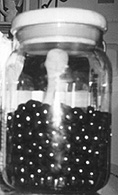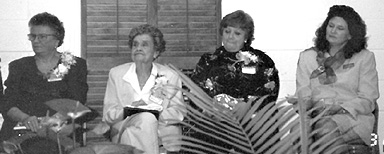
Dock of the Bay

Volume VI Number 12
March 26 - April 1, 1998
Bats and Trowels: Homestead Enlivens Oriole Park with Flowers, Color
Most Marylanders are counting on the Baltimore Orioles
blossoming into the World Series this season for the first time this decade.
But the only sure bet is that Oriole Park
at Camden Yards will be blooming - thanks to Anne Arundel's premier nursery.
is that Oriole Park
at Camden Yards will be blooming - thanks to Anne Arundel's premier nursery.
Even before we see the Orioles' Opening Day squad take the field March 31, a team from Homestead Gardens in Davidsonville will have planted thousands of pansies, snapdragons and tulips in vast areas on the grounds outside the park.
"We want to bring in a little theater, a little drama," observed Rob Graham, manager of Homestead's landscaping division.
The springtime plantings will be wrapped up by this weekend. It is the first of several intricate designs by Homestead on thousands of square feet at three areas around the park. In addition, Homestead's hanging baskets will be flying alongside the Orioles banners on antique replica light fixtures.
The arrangement was worked out in a series of meetings between Orioles officials, the Maryland Stadium Authority and Homestead, one of the nation's largest full-service garden centers. The stadium authority, which owns the property, had been planting flowering shrubs and mulching the grounds.
Homestead's new plantings will bring drifts and waves of color to the stadium; they are modeled after ornate landscaping at Disney World in Florida, where Homestead president Don Riddle and others visited this winter.
From the sound of it, fans coming and going near the south side of Camden Yards, at Schaefer Circle or near the Babe Ruth Plaza, will have something to cheer even if the home team wilts.
The cold-hardy pansies will be yellow and pearly white mixed with snapdragons in orange and white. Homestead also is planting loads of hostas. And this is just a temporary arrangement.
Come mid-May, trucks will arrive with pink petunias able to withstand searing summer heat, pink-to-mauve impatiens, silver dusty miller and purple heliotrope. Fan palms and cannalilies will lend an exotic texture. That's not all: Red fountain grasses and black-eyed Susan (Maryland's state flower) will adorn the grounds.
The color scheme is important but not as critical as the quality of the display and the endurance of the flowers, Graham noted.
After all, 40,000 people will be tramping by, more concerned about batting practice or traffic than where their feet alight. Maintenance was a prime concern in the discussions, and Homestead will work through the season to protect the gardens in regular ventures to Camden Yards.
Of course, visiting the ballpark is not exactly a chore for Rob Graham, who grew up in Towson an ardent fan of the Orioles. "When I'm up there and I stand and look at statues of some of these players, I'm proud to be doing this project," said Graham, 46, now of Davidsonville.
There's even a plan for special playoffs and World Series plantings if Marylanders are so fortunate. Speaking like a fan rather than a landscape artist, Graham says Homestead will oversee a special fall planting when - not if - the Orioles are playing into October.
"It will be like icing on the cake," he promised.
-NBT
photo by N.M. Knoll
Maryland History Writ Small in Charlotte Hall; Village Doctor Tells Tales
A step back into the early days of historic Southern
Maryland is only a short drive away. If you have in hand a recently published
book, Charlotte Hall, The Village, 1797-1997, your return will be brightened
by homespun stories and colorful stories of life in Colonial, Victorian
an d 20th century years.
d 20th century years.
Charlotte Hall, The Village is a small gem of a book written by a native of the area, Dr. J. Roy Guyther, who began practicing general medicine in St. Mary's County 50 years ago. He traces the history of the 200-year-old village of Charlotte Hall primarily in human terms.
"Too often we hear about historic places in the past tense," writes Richard Moe, president of the National Trust for Historic Preservation, in the foreword. "This book reminds us of how fortunate we are to be able to visit - and experience - the Village of Charlotte Hall first hand."
The village, in St. Mary's County, is close to Route 5 and Charles County's southern border. It has fewer than 200 residents, but 13 of its homes are more than 100 years old, and the village is listed on the National Register of Historic Places.
Charlotte Hall shares its site with "Ye Coole Springs," where converge several natural springs that were believed by the Indian tribes to possess "magical powers." In 1698 a hospital or sanitorium was built there to, in Dr. Guyther's words, "serve Southern Marylanders who believed that the fresh spring water possessed medicinal healing qualities."
In 1774, the village began to grow as Charlotte Hall School was established to consolidation all the "free schools" in the four Southern Maryland counties. In 1852, it became Maryland's first military preparatory school. Today the school lives on as the Charlotte Hall Veterans Home.
Guyther's descriptions of the centuries-old homes still seen on either side of Old Route 5 detail not only the structures but also the lives and views of the people who lived there. Histories of houses, families, schools, churches, physicians and the country store are rich with anecdotes and documents.
One dwelling, the Briscoe House, is occasionally referred to in Guyther's researches as the site of a former tavern or inn built circa 1690. "The latter designations," he writes, "are somewhat in doubt as the Board of Trustees of the school were very zealous in prohibiting the sale of spirituous liquors within a mile of the school."
Other stories tell of the efforts of the Union Army to recruit young men during a school dance and slaves from the fields; about the deadly history of Smoot's Pond, which claimed several lives over the years; and about long-ago religious and political controversies.
One of those controversies raged in the 1920s, when there was "grave concern [among the school trustees] that the store of John Fowler had slot machines nefarious devices [that] would tempt and contaminate the virtues of the students." The report was a portent of controversies ahead.
Guyther's medical training often adds a new depth to stories, including a 1917 drowning at Smoot's Pond. He relates it to his own near-drowning experience, when "endorphins kicked in, a calming feeling came over me so, often death is not a horrendous experience."
"The architectural resources are marvelous;" writes Richard Moe of the National Trust for Historic Preservation, and "the stories behind them even more so."
"The narrative," writes Guyther in his preface, "is not an effort to value the past over the present but to record events which have occurred over the last two centuries so that the reader may be content in the knowledge that the 'good old days' weren't so good after all."
The author has also written Mechanicsville, The Story of Our Village, about a neighboring town, founded in the mid-1800s, a few minutes south of Charlotte Hall off Route 5. That book won the 1997 Heritage Book Award from the Maryland Historical Trust. The Trust describes it as a fine text that accurately chronicles the historical development of the village.
"A downhome factual account," said Potomac Review.
Mechanicsville includes not only stories about historic homes, but also information about the Amish population, the moonshine business, home life, country entertainment, stores, old hotels, families and personalities.
In one account, a priest forbade his parishioners from attending the Adams Floating Theater on the Potomac in Leonardtown, and the next performance attracted a crowd that "overwhelmed the capacity of the boat."
Both books are tour guides chronicling in comfortable conversational style the stories of tiny villages evolving and surviving over the centuries, almost untouched by wars and conflicts. Through them we see life in Southern Maryland with dry wit, compassion and shrewd historic perspective.
Mechanicsville, although currently out of print, may be found at some libraries including Leonardtown Public Library and the Pratt Library. To purchase Charlotte Hall, send $25 plus $2.50 for tax, postage and handling to J. Roy Guyther, M.D., 28175 Old Village Road, Mechanicsville, MD 20659.
-Val Hymes
 "Coffee
sets the blood in motion."
"Coffee
sets the blood in motion."
-Balzac
If you're planning to participate in the flourishing Annapolis coffee house scene, you must be careful.
"Sometimes a cup of coffee is just a cup of coffee," warns Rafael Guerra over a cappuccino at Café Gurus, Eastport's hottest java stop. "Sometimes, though, it can be so strong it seems to blow your heart through your chest."
So sip gently.
Of course, you may be a coffee fiend, a person who craves the caffeine O.D. For you, a weak brew is a nuisance. For you, shivery hands and the wide awake feeling of too much coffee are pleasant sensations.
And for you, chocolate-covered coffee beans are appearing with increasing frequency on the shelves and counters of the city's cafes. Spared the caffeine-draining process of brewing, these sweets consistently pack a mean punch.
"They sell like crazy," says Nicki Page, a barrista, or coffee
drink preparer, at the Pony Espresso on West Street. In her shop, the bea ns sit in an old candy store jar and sell for $10 a pound.
ns sit in an old candy store jar and sell for $10 a pound.
"People buy them for the fun of getting an extra kick," says Page. "They'll stop in, buy a handful and then they're out the door." Candies make a direct appeal to the palate. "They're crunchy, they're sweet and you can barely taste the bitterness of the bean," says Peter Cada, who works at 49 West Coffeehouse. Yet, he adds, "they offer the same impact as espresso. In fact, they're very convenient that way. And they make people feel good."
49 West's owner Brian Cahalan also attributes the beans' popularity to their flavor. "People love these beans; even people who don't like coffee enjoy them. The two flavors go together well - like wine and cheese." Cahalan suspects that the beans would be more popular - if they were less stimulating.
But full of caffeine, the beans are riding a high. "We're always keeping our dispenser full of them," says Web Chamberlin, co-owner of City Dock Cafe. He's been selling them since 1993 and the beans, he says, have become associated with the coffee house culture. "Things like chocolate-covered coffee beans - and other unique products, like biscotti and chocolate covered pretzels - sell best in an atmosphere like a cafe. This is a place to find them."
Find them you can- in boxes, jars and gumball machines - in almost every cafe in the city.
But remember: Be careful.
Caffeine is terribly addictive. A handful of chocolate-covered coffee beans may lead - rather quickly - to a greater and greater mocha dependency. Remember this, as you consider your entrance into the world of the coffee house.
Yes, for heaven's sakes be careful.
-Steve Armstrong
As Prez Seeks Haven, A.A. Dems Party in Rose Haven
Below, Sen. Barbara Mikulski, right, with Democratic activist Louise Dunlap. Gov. Parris Glendening, far below.
You wouldn't have known that their president was in hot water as 300
Democrats gathered at Herrington Harbour in Southern Anne Arundel last week
for their annual Jefferson-Jackson Day dinner.
They may have been whispering about President Bill Clinton's peccadilloes but not a word was uttered publicly at the gathering, just days after another woman alleging improper behavior by the president.
Instead, Democrats seemed intent on the next big prize - holding the governor's office for Parris Glendening - and beefing up party registration.
"If we do not win the governorship in 1998, we are all in trouble," exhorted U.S. Rep. Steny Hoyer, intoning a party strategy of painting Republican aspirant Ellen Sauerbrey as an extremist. "Our state is in trouble. Our families are in trouble. Our children are in trouble."
State Comptroller Louis Goldstein, ever the pragmatist at 85, fetched a dog-eared clipping from his baggy coat and admonished Democrats to hasten voter registration efforts. The clip showed that Republicans had out-registered Democrats two to one in Anne Arundel since Glendening took office three years ago - and nearly three to one statewide.
"You Democrats had better get busy and get all of these new people to register as Democrats," Goldstein said.
Sen. Barbara Mikulski recalled Goldstein reminding her of the correct pronunciation of Calvert County as she made her first statewide rounds. "'Calvert is the whisky; Culvert is the county. Enjoy them both'," she recalled.
The theme of the event was: Democrats on the Bay - an Old Maryland Tradition.
As Glendening and Mikulski made the rounds, Democrats feasted amply on rare
roast beef, oysters on the half-shell, bite-sized ham biscuits and pumpkin
puffs. Herrington Harbour's cozy setting provided relief from a pelting
rain - not to mention news of the president's
travails.
to mention news of the president's
travails.
"My women friends and I talk about it all the time," said Del. Virginia Clagett of Clinton's latest problems. "He's been a good president " she said, her voice trailing off.
Senate President Thomas V. Mike Miller shook his head in wonderment in recounting how the president's rating in polls spiked upward again last week - to mid-60 percent approval ratings - in the days after the CBS "Sixty Minutes" interview with a woman alleging impropriety by the president.
Miller suggested that it would take a truly serious scandal or a plummeting stock market for people to lose faith in Clinton. "I think it says that if you speak up for people, they're willing to forgive," Miller said.
Glendening said that he doesn't pay much attention to Clinton's personal life and he believes most people don't either. "I think there's a concern about [Whitewater prosecutor Kenneth] Starr. Most Americans wonder what he's doing," Glendening said.
Glendening was behaving like an officeholder intent on keeping his job; he was up and down Herrington Harbour's two floors more than some of the staff. Of course one of his primary challengers, Harford County Executive Eileen M. Rehrmann was working the crowd herself.
Glendening, a former college professor, never was regarded as a natural when it comes to the chit-chat and glad-handing that is the currency at such events. Asked about campaigning, Glendening replied: "I like it. I like being governor."
Most Anne Arundel Democrats are hoping that the Glendening will be saying the same words in the present tense at the Jefferson-Jackson Day bash a year from now.
-NBT
Chamber Music in Memory of Sara
Watkins
Sara Watkins, at right, whose December death left Annapolis chamber orchestra without a conductor, will be commemorated in a concert conducted by Markand Thakar, below.
Sara Watkins should have held the baton at the Annapolis Chamber Orchestra's second concert this Saturday, as she did at the first, last September. Instead, she is present in memory.
Watkins died last December, stricken by an aneurysm in the prime of life as she rehearsed a concert.
"This is the way she would have wanted to be remembered," says Jane Schorsch, the executive director of the Annapolis Symphony Orchestra, "her friends and colleagues making music together."
In Watkins' place, a colleague from the Peabody Institute in Baltimore, Markand Thakar, conducts the orchestra. "She's not here. Nothing we can do will change that," says Thakar. But we can "acknowledge the gravity of living and dying, as we honor her spirit and memory."
A consummate chamber musician, Watkins will be honored with a program of music, reminiscent of 18th century Europe when musicians lived and played in the chambers of castles. On the program are Bach, Mozart and the more modern Copland, plus a repeat from the first concert of Barber's Adagio for Strings.
The composer Franz Joseph Haydn is, perhaps, the most famous example
of such musicians. Haydn was hired as Kapellmeister in 1761 by Prince  Esterhazy, head of the richest family in Hungary.
Esterhazy, head of the richest family in Hungary.
Imagine sitting in a very large living room, near a group of musicians ready to play. Music written for such a setting has a singular intimacy and charm. In the colloquy of the instruments, one to another, the proximity of the music sets up a reply in the heart of the listener.
The Bach Concerto for Violin and Oboe, heard right after intermission, honors Watkins as the first woman to be principal oboist of a major American orchestra. The oboe soloist is Fatma Daglar, who studied with Watkins and who soloed in the Bach piece presented in September. Right after that wonderful performance, Daglar won an audition to become principal oboist of the Annapolis Symphony Orchestra.
The final work of the program, the repeat performance of Barber's Adagio for Strings, expresses the gamut of human emotions - hope, anger, and ultimately acceptance. Thakar calls it a piece "that [can] allow us to think and reflect - not to mourn but to reflect."
Good tickets are still available for this Saturday night concert at 8pm at Maryland Hall for the Creative Arts, 801 Chase St., Annapolis: 410/263-0907.
-NBT
Four More Her-oes Named in Calvert
Calvert County's newest Her-oes, below, Marge Wooten, Dixie Moran, Sharon Eskins and - on behalf of Audrey Evans - Kathie Smith.
Since 1982, over 150 women have been recognized by the Calvert County Commission for Women - yet they keep finding more. All have made their county a better place in which to live and work.
Feted on March 21 at a reception attended by over 70 of their friends, neighbors and elected officials, four more women follow in the footsteps of earlier Women of Recognition.
Nominated by organizations, friends, family and co-workers, these four Calvert County women reach from children's issues to making life easier for people in need.
"When I was recognized Saturday night, I thought I would blow up
I was so happy," enthused Dixie Moran. "People were applauding,
it was so personal, the politicians - George Owings, Mike Miller and the
others - handed me my award, hugged and kissed m e.
It was wonderful."
e.
It was wonderful."
Moran, a member of St. Anthony's Ladies of Charity, spreads her humor and dedication throughout the county, working to ease the life of her neighbors. In the 1970s, she and a friend founded Food Pantry. They delivered food from their cars, driving around the Beaches.
Today at age 87, Moran can still be found volunteering, although the pantry has lost its small town flavor and grown in size and paper trails by accepting government help. Her son and daughter now work alongside her.
In addition to Dixie's work with needy neighbors, the Commission recognized a career woman's influence on local government service. Audrey Evans, clerk of the Circuit Court from 1977 to 1997, began work in the clerk's office in 1969. For all those years, according to her staff, she has "set a high standard for this office with her even disposition, willingness to listen and approachability."
Beyond her paying job, Evan's expertise flows into general community work. The Cancer Society, Aid to Retarded Citizens and Anne Marie Gardens benefit from her professionalism and care.
Child safety is another issue recognized by the Commission for Women. Involved with child safety through her work as chairperson of the Calvert County Safe Kids Coalition, Sharon Eskins also teaches the fire prevention programs in county schools. She has designed a children's book on fire safety and written grants for car safety seats.
Rounding out the quartet recognized this March is Marge Wooten. Many of Wooten's volunteer activities revolve around her faith. She devotes time to Catholic Charities and visits the sick at Calvert Memorial Hospital as a eucharistic minister. Described as, "a tireless worker for the good of our community," Wooten puts a personal touch on meal preparation for the homeless at Project Echo, the county's shelter.
Calvert Countians have another year to look around and notice women who are making a difference in their community. At the end of 1998, the Calvert County Commission for Women will be looking for nominations of other women to follow in the footsteps of Dixie Moran, Audrey Evans, Sharon Eskins and Marge Wooten.
There seems to be an endless supply of women who give of themselves to make Calvert County a caring place. That's lucky for all of us.
-CG
In Michigan, the nose of an Oakland County commissioner is way out of joint because of the new designation of Vermont's Lake Champlain as a Great Lake, a special designation to obtain Sea Grant moneys. The commissioner called on Michigan residents to boycott Vermont maple syrup, prompting a spokesman for Vermont to ask: "What do we do? Not buy cars?"
Near Orinda, Calif., the East Bay Municipal Utility District decided last week to ban gasoline-powered boats on San Pablo Reserve unless manufacturers develop an engine that does not emit pollutants
In San Francisco, the environment must be even more important than the church. City environmental concerns, a city land agency voted last week to seize coastal land owned by Russian Orthodox nuns. The nuns in their 70s and 80s, planned to build an 18-room convent on a cliff...
Boston Globe reporters asked elementary school students to design the flip side of the state's new commemorative quarter. They expected Pilgrims, Plymouth Rock and historical stuff. What they got was decidedly un-Boston - a manatee and a polar bear
Our Creature Feature this week comes to us from Maine, where lobster fishermen are happy about last year but fretful as to what lies ahead. The National Marine Fisheries Service reported last week that lobster boats shattered all previous records last year by bringing in 46.3 million pounds of the delectable crustacean.
But there are warning signs out there. More traps than ever were in the water last year and 90 percent of the catch had barely reached minimum size and were too young to reproduce. Because of the worries, the Maine Legislature is considering a moratorium on new lobster licenses through 1999.
| Back to Archives |
Volume VI Number 12
March 26 - April 1, 1998
New Bay Times
| Homepage |